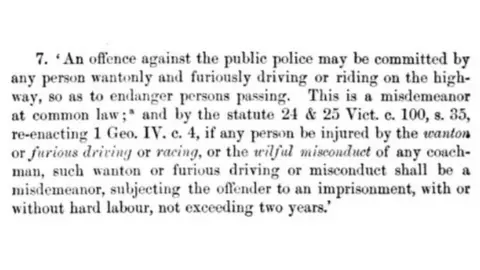Husband says ‘reckless’ cyclists must learn from wife’s death
The husband of a woman who was knocked down and killed by a cyclist has urged "reckless" riders to learn from his wife's death.
Kim Briggs, 44, was hit while crossing the road in east London last year.
Matthew Briggs has criticised the "fetishism" of cyclists riding fixed gear bikes with no front brake and is calling for a change in the law.
It comes a day after Charlie Alliston, 20, was found guilty of causing bodily harm by "wanton or furious driving".
Alliston, who was cleared of manslaughter, was riding a fixed gear bike with no front brakes when he hit the mum-of-two.
She suffered "catastrophic" head injuries and died a week later in hospital.
Mr Briggs told BBC Radio 4's Today programme he was campaigning for a change in the law because "sometimes in life you have to step up and do the right thing".
He called for cycling to be incorporated into the Road Traffic Act with the creation of new offences, such as causing death by dangerous cycling, death by careless cycling and causing serious injury.
 PA
PAMr Briggs described his wife as the "most wonderful woman, the most fun loving woman".
He said he was launching a campaign for a change in the law to honour his wife, and to "try and stop another family having to go through what we have had to go through".
"I've lived in London for 28 years. I cycle in London, this is not a witch-hunt against cyclists."
"This is dealing with a specific issue of reckless cyclists and also those people who choose to ride fixed wheel bikes without the front brake."
 PA
PAMr Briggs said riding fixed gear bikes with no front brakes was a fashion statement bordering on fetishism.
To those who rode bikes without a front brake, he said: "I would just urge them to read my story. To understand what happened to my wife, mother of two, the most wonderful woman, the most fun loving woman who went out to work and didn't come back.
"Why would you take that risk with somebody else's life? And even at the most selfish why would you endanger yourself?"
Asked on BBC Radio 5 live how his children were coping with the loss of their mother, Mr Briggs said: "My children are amazing. My children are the reason I get up every single morning. They are resilient, they are funny, they are full of life.
"They are an absolutely credit to their mother who brought them up with joy, with laughter, with compassion and I'll do the same. They are the reason I'm doing this. I just love them from the bottom of my heart."

What is wanton and furious driving?
 Commentaries on the Laws of England
Commentaries on the Laws of EnglandAlliston was charged with an admittedly archaic offence - but it is the closest to dangerous driving a cyclist can be charged with.
Unlike a dangerous cycling charge, causing GBH by wanton and furious driving takes into account injury.
It may sound slightly eccentric, but perhaps it is down to its wording which was coined in 1861.
Introduced under the Offences Against the Person Act, the charge was created to deter people from driving horse carriages recklessly.
It is now used when it is not possible to prosecute under the Road Traffic Act 1988 - ie, when the vehicle in the crime was not mechanically propelled - and in cases of serious injury or death caused by a cyclist's actions.
It carries a maximum penalty of two years' imprisonment and/or an unlimited fine.
Previous successful prosecutions under the offence include those against cyclists Darryl Gittoes and Darren Hall, who both knocked down pedestrians who later died.

